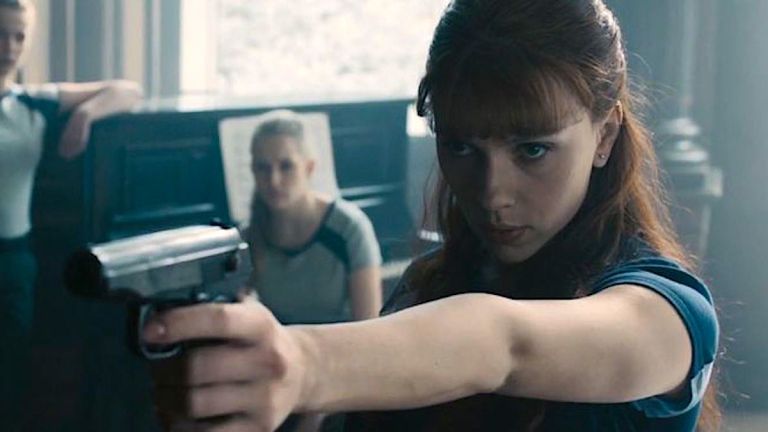Black Widow: The Disturbing Real Spy History Inspirations
If even only briefly, Black Widow is the rare Marvel movie that considers its real world context.

This article contains Black Widow spoilers.
Black Widow is the first Marvel Studios release to have an opening credits sequence since 2010’s Iron Man 2. Which by itself is kind of nice. After all, both movies bookend Scarlett Johansson’s tenure in the role of Natasha Romanoff. Yet when watching the opening moments of Marvel’s latest adventure, the decision to include an ominous montage of young Nat’s childhood after the movie’s brutal cold open is about more than creating symmetry with the past; it fills in the most mysterious Avenger’s blindspots… and reveals the red in her ledger is also our own.
Scored to a haunting cover of Nirvana’s “Smells Like Teen Spirit,” Black Widow’s opening titles dovetail out from one of the movie’s best moments. With a stripped down prologue devoid of space gods and magic rocks, Black Widow’s first 10 minutes wouldn’t look out of place in a Tom Clancy adaptation or an hour of premium cable TV: Young American girls Natasha and Yelena (Ever Anderson and Violet McGraw) have the comforts of their midwest childhoods ripped away when their “father” Alexi (David Harbour) reveals to “mother” Melina (Rachel Weisz) that their cover is blown. American authorities are coming to arrest them as Russian spies, and they need to leave the country. Now.
While the following car chase features some of Marvel’s typical bells and whistles, there is an impressive restraint implemented (at least initially) by director Cate Shortland. The movie minimizes the CG spectacle here but ups the on-the-nose Americana: high school football, rock and roll, and literal “American Pie” of the Don McLean variety. This is a story about a sham “family” of four Russian spies seeing their illusionary bliss shattered, and their innocence stolen. The implications then become explicit during the unusually bleak title sequence which juxtaposes Nat’s sterile and cruel girlhood with the geopolitical chaos that closed out the 20th century.
Unlike nearly every Marvel film not named Iron Man or Black Panther, there is a momentary consideration for the real world context in which these flights of comic book fancy are borne, and how grim post-Cold War espionage would be for a superhero’s origin story. With fleeting snapshots of young Natasha and Yelena asked to imitate happy Christmastime memories for phony family photos, or being brainwashed inside the fabled Red Room’s ballet studio, Black Widow echoes actual horrors from the recent past…
Russian Spies on American Soil
The story of Russian spies infiltrating American borders is of course nothing new. Julius and Ethel Rosenberg made international headlines in 1950 when the American couple was arrested, and later convicted, for spying on behalf of the Soviet Union. Indeed, they were the first Americans executed during peacetime for espionage after they were revealed to have smuggled nuclear weapon designs to Russia.
Of course the childhood origins of Natasha and Yelena better resemble more recent Russian spy games, including sleeper cells who operated in the U.S. for decades. Like FX’s The Americans TV series before it, the prologue and opening credits of Black Widow appear to be greatly inspired by a Russian spy ring arrested by the FBI in 2010.
Dubbed the “Illegals Program” by American law enforcement, the Russian spy network dated back to the early 1990s and was implemented after the fall of the Soviet Union by the SVR—Russia’s foreign intelligence service which replaced the KGB. Designed to place Russian spies in positions of influence and access in American government, business, and academia, the program included 11 spies operating in locations as far flung as New York City and Seattle, and Boston and northern Virginia.
While the program never successfully achieved its reported aim to gather information on America’s nuclear weapon arsenal, foreign policy toward Iran, or access to CIA or congressional leadership, it did in retrospect presage the soon-to-be chilling relationship between the U.S. and Russia.
It also required intricate false identities, aliases, and cover stories which led to some Russian operatives starting families in the guise of blending in. For instance, Vladimir and Lidya Guryev arrived in the U.S. in the 1990s under the names Richard and Cynthia Murphy. Cynthia proved especially adept at adapting American life, if not gathering pertinent state secrets. In 1997 she earned an associate degree from NYU, and in 2000 an MBA from Columbia University. During that entire time frame, she worked at a prestigious Manhattan accounting firm, taking home an annual six-figure salary.
The couple also gave birth to two daughters during their time as Russian sleeper agents, with both children being American citizens when their parents were arrested in 2010. The daughters were ages 11 and nine at the time, and were forced to follow their parents back to Russia after they were swapped with Americans convicted of espionage in Russia.
Similarly, Andrey Bezrukov and Yelena Vavilova were assigned the task of becoming Donald Heathfield and Tracey Lee Ann Foley while still a young Russian couple. They moved to Canada to more easily establish false identities before immigrating to the U.S., with “Donald” eventually studying at Harvard. Their two sons Tim and Alex were born in Canada and were ages 20 and 16 when their parents were arrested. Despite having Canadian passports and having never even been to Russia, they were stripped of their citizenship, which as of the publication of an in-depth profile in the Guardian in 2016, they were still fighting to get back.
“I never had anything close to a suspicion regarding my parents,” Alex told the British newspaper. “It seemed all my friends’ parents led much more exciting and successful lives.” It didn’t even seem quite real to Alex and his brother until they went to Russia and were shown photographs of their parents in their 20s—in officers’ uniforms and adorned with medals.
Perhaps the most famous spy from this ring remains redheaded Anna Chapman, who the press in 2010 dubbed the “sexy Russian spy.” In fact, The Independent reported that the FBI’s then-counterintelligence chief Frank Figliuzzi said she was getting “closer and closer” to possibly seducing a member of the Obama administration’s cabinet in a classic “honeypot” scenario.
However, Figliuzzi said he was misquoted and they were worried about her proximity to American officials, not “seduction.” Cynthia Murphy, however, did establish contact with a friend and fundraiser of Hillary Clinton’s 2008 presidential campaign. Clinton was then the Secretary of State.
Since being deported to Russia, Chapman became a model and social media celebrity… and a vocal supporter of former President Donald Trump.
The Real Red Rooms
Another aspect that looms over Black Widow’s opening credits and beyond is the depravity of the Red Room, an institute we see teased in the movie’s title sequence when Ray Winstone’s interpretation of slime-incarnate, Col. Dreykov, tells young Natasha the school “is your home.” Viewers are also later reminded this is where Natasha was sterilized as a teenager after being taught to kill, and an older Yelena (Florence Pugh) was literally brainwashed with mind-altering drugs.
While mind control and sterilization appear to be fanciful additions made by Marvel, Soviet espionage schools for young women and otherwise were a definite product of the Cold War era. While details remain obscured even decades after the Iron Curtain fell, CIA officers and even some former Russian intelligence personnel have given peaks behind the shroud. Former KGB Lt. Gen. Leonid Vladimirovich Shebarshin recalled living in a “dilapidated” dormitory while being trained in espionage and surveillance.
And a school specifically designed to train women to use sex and seduction as tools of spyycraft did exist. According to multiple former CIA officers, it was located in Kazan, the capital of the Republic of Tatarstan in Russia. Graduates of the program, variously known as “swallows” in the espionage world, inspired many Cold War stories, including how the Widow program is depicted in the MCU.
Jason Matthews, who worked as a CIA officer for over 30 years, including in Europe during the Cold War, explored the sordid details as an author in his Red Sparrow trilogy, which the CIA officially reviewed as “accurate [and] richly detailed.”
“The Russians have for many, many years, used women to try and sexually entrap [high-ranking foreign officials] for blackmail purposes, to try and tell their secrets,” Matthews told CNBC in 2018. And while he said the Kazan “Sparrow School” has been closed down, those honeypot operations persist.
Indeed, Jonna Mendez, a former CIA chief of disguise and a member of the International Spy Museum’s Board of Directors, confirmed the Kazan swallows school. In a 2018 interview, she told The New York Times about the time a swallow compromised a U.S. Marine stationed in Moscow during the 1980s. After being enticed by the Soviet spy, he allowed her and several other women (also likely swallows) into the American embassy. The marine was later convicted of allowing a security breach.
“It was a seduction scenario not unlike what you would have [seen in the Red Sparrow movie],” Mendez said.
The Menace of Dreykov
The real world seediness of the Red Room and Widow program’s inspirations is only matched by the darkness of Dreykov. To go back again to the movie’s opening credits, it’s disquieting in the way the villain of the film is juxtaposed. He is not seen rubbing shoulders with Thanos or a cameoing Vulture, nor is he depicted as in pursuit of some mythical MacGuffin.
When we get our first good look at Dreykov, he’s visiting the Rose Garden with President Bill Clinton, who occupied the White House during the film’s 1995 prologue. Another shot in the credits show him meeting with Condoleezza Rice, who was President George W. Bush’s National Security Advisor and then later his second Secretary of State. She participated in the meetings that led to decades of war in the Middle East, including the invasion of Iraq and its quest for nonexistent weapons of mass destruction.
When coupled with actual shots of the beginning of the Iraq War in 2003—which would’ve been around the time Natasha “graduated” from the Red Room—the implication is obvious: Dreykov is orchestrating or participating in world events from the shadows. While the film never overtly states Dreykov played a role in shaping American or Russian foreign policy at the turn of the century, it is nonetheless heavily inferred as his root motivation, much like the menace of sexual manipulation and violence in a school inspired by actual Soviet era honeypot programs.
In fact, during the climax of Black Widow, Dreykov is revealed to be a sleazy amalgamation of multiple predatory men in power who’ve finally seen their reckoning in the last several years. During their final confrontation, Dreykov looms over Johansson’s Natasha like a brute trying to intimidate a woman by his girth and the implicit threat of violence. He’s a toxic blend of every account about Harvey Weinstein or Roger Ailes trying to manipulate and assault women, or the way a certain presidential candidate purposefully stalked around a debate stage to loom over his female rival.
It also mirrors the disturbing connections that some of these serial abusers possessed. Convicted sexual offender, pedophile, and child sex trafficker Jeffrey Epstein famously associated with leaders of every political stripe, visiting the Clinton White House four times, and having the former president fly repeatedly on his private jet. Donald Trump, meanwhile, flew on the same plane, multiple times according to Epstein’s brother Mark. Epstein was also a member of Trump’s Mar-a-Lago club where at least one underage girl was allegedly preyed upon and groomed into Epstein’s sex ring. Epstein was eventually banned from the resort in 2008, but that came after he was indicted by a grand jury for soliciting child prostitution.
In 2002, Trump told New York Magazine, “I’ve known Jeff for fifteen years. Terrific guy. He’s a lot of fun to be with. It is even said that he likes beautiful women as much as I do, and many of them are on the younger side. No doubt about it — Jeffrey enjoys his social life.”
The Marvel Method
That a Marvel Studios film would wade into any of this, even with the lightest of steps and most diminutive of glances, is a surprise. Which is not to say Black Widow—a movie which features a flying mansion fall from the sky—is some kind of pensive commentary on the exploitation of women, be it in espionage or other halls of power. It’s a superhero movie, and one made by Disney, no less.
And yet, in its own way, it is a superhero movie that at least reflects the world it’s made in, thereby offering something more tactile than most Marvel alternatives. It also provides an entirely euphoric catharsis. From the opening credits to the ending resolution, we witness in all its comic book trappings how powerful men embodied by Dreykov use and abuse women’s bodies, often beginning when they’re still girls who can be indoctrinated into what’s “expected” of them.
Seeing Scarlett Johansson sever her own olfactory nerve to break the power of a man like this and then beat him to a pulp— signaling to her target audience they are not just the tools or playthings of the society around them—is the kind of spy game we should watch play out a lot more.


